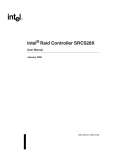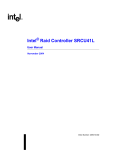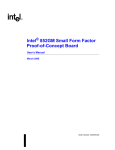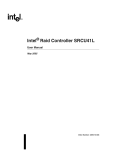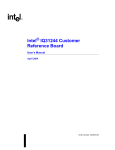Download Tektronix MSO4000 Landscape Lighting User Manual
Transcript
Intel® Embedded Compact Extended Form Factor Proof-of-Concept Board Based on Intel® 915GM Chipset User’s Manual June 2007 Order Number: 310915-002 Contents INFORMATION IN THIS DOCUMENT IS PROVIDED IN CONNECTION WITH INTELR PRODUCTS. EXCEPT AS PROVIDED IN INTEL’S TERMS AND CONDITIONS OF SALE FOR SUCH PRODUCTS, INTEL ASSUMES NO LIABILITY WHATSOEVER, AND INTEL DISCLAIMS ANY EXPRESS OR IMPLIED WARRANTY RELATING TO SALE AND/OR USE OF INTEL PRODUCTS, INCLUDING LIABILITY OR WARRANTIES RELATING TO FITNESS FOR A PARTICULAR PURPOSE, MERCHANTABILITY, OR INFRINGEMENT OF ANY PATENT, COPYRIGHT, OR OTHER INTELLECTUAL PROPERTY RIGHT. Intel Corporation may have patents or pending patent applications, trademarks, copyrights, or other intellectual property rights that relate to the presented subject matter. The furnishing of documents and other materials and information does not provide any license, express or implied, by estoppel or otherwise, to any such patents, trademarks, copyrights, or other intellectual property rights. Intel products are not intended for use in medical, life-saving, life-sustaining, critical control or safety systems, or in nuclear-facility applications. Intel may make changes to specifications and product descriptions at any time, without notice. Intel may make changes to specifications and product descriptions at any time, without notice. Designers must not rely on the absence or characteristics of any features or instructions marked "reserved" or "undefined." Intel reserves these for future definition and shall have no responsibility whatsoever for conflicts or incompatibilities arising from future changes to them. The Intel Embedded Compact Form Factor Single Board Computer Interface may contain design defects or errors known as errata which may cause the product to deviate from published specifications. Current characterized errata are available on request. MPEG is an international standard for video compression/decompression promoted by ISO. Implementations of MPEG CODECs, or MPEG enabled platforms may require licenses from various entities, including Intel Corporation. This document and the software described in it are furnished under license and may only be used or copied in accordance with the terms of the license. The information in this document is furnished for informational use only, is subject to change without notice, and should not be construed as a commitment by Intel Corporation. Intel Corporation assumes no responsibility or liability for any errors or inaccuracies that may appear in this document or any software that may be provided in association with this document. Except as permitted by such license, no part of this document may be reproduced, stored in a retrieval system, or transmitted in any form or by any means without the express written consent of Intel Corporation. Contact your local Intel sales office or your distributor to obtain the latest specifications and before placing your product order. Copies of documents which have an order number and are referenced in this document, or other Intel literature, may be obtained by calling 1-800-548-4725, or by visiting Intel's website at http://www.intel.com. AlertVIEW, AnyPoint, AppChoice, BoardWatch, BunnyPeople, CablePort, Celeron, Chips, CT Connect, CT Media, Dialogic, DM3, EtherExpress, ETOX, FlashFile, i386, i486, i960, iCOMP, InstantIP, Intel, Intel logo, Intel386, Intel486, Intel740, IntelDX2, IntelDX4, IntelSX2, Intel Create & Share, Intel GigaBlade, Intel InBusiness, Intel Inside, Intel Inside logo, Intel NetBurst, Intel NetMerge, Intel NetStructure, Intel Play, Intel Play logo, Intel SingleDriver, Intel SpeedStep, Intel StrataFlash, Intel TeamStation, Intel Xeon, Intel XScale, IPLink, Itanium, LANDesk, LanRover, MCS, MMX, MMX logo, Optimizer logo, OverDrive, Paragon, PC Dads, PC Parents, PDCharm, Pentium, Pentium II Xeon, Pentium III Xeon, Performance at Your Command, RemoteExpress, Shiva, SmartDie, Solutions960, Sound Mark, StorageExpress, The Computer Inside., The Journey Inside, TokenExpress, Trillium, VoiceBrick, Vtune, and Xircom are trademarks or registered trademarks of Intel Corporation or its subsidiaries in the United States and other countries. This device is protected by U.S. patent numbers 5,315,448 and 6,516,132, and other intellectual property rights. The use of Macrovision's copy protection technology in the device must be authorized by Macrovision and is intended for home and other limited pay-per-view uses only, unless otherwise authorized in writing by Macrovision. Devices incorporating Macrovision’s copy protection technology can only be sold or distributed to companies appearing on Macrovision’s list of “Authorized Buyers” at: www.macrovision.com. Reverse engineering or disassembly is prohibited.” *Other names and brands may be claimed as the property of others. Copyright © Intel Corporation 2007. All rights reserved. Contents Contents 1 Product Overview ............................................................................................................5 1.1 Introduction ...........................................................................................................5 1.2 Related Documents...............................................................................................5 1.3 Product Contents ..................................................................................................6 1.4 Proof-of-Concept Board Features..........................................................................6 1.5 Intel® ECX Form Factor POC Board Based on Intel® 915GM Chipset Block Diagram ................................................................................................................8 2 Installation Guide for POC Board ...................................................................................9 2.1 Before You Begin..................................................................................................9 2.2 Setting up the Intel® ECX POC Board...................................................................9 3 Connectors and Jumpers..............................................................................................14 3.1 List of Jumpers....................................................................................................15 3.2 List of Connectors ...............................................................................................17 Figures Figure 1. Block Diagram ....................................................................................................8 Figure 2. Assembly board, Top View................................................................................11 Figure 3. Assembly board, Bottom View...........................................................................11 Figure 4. 20-pin Power Supply Connector........................................................................12 Figure 5. Connectors and Jumpers ..................................................................................14 Figure 6. Solder Side .......................................................................................................15 Tables Table 1. Related Documents..............................................................................................5 Table 2. Additional Hardware.............................................................................................9 Table 3. Jumper Settings .................................................................................................10 Table 4. Jumpers.............................................................................................................15 Table 5. Compact Flash Power Select (JP1) ...................................................................16 Table 6. LVDS Voltage select (JP2) ................................................................................16 Table 7. COM1 Mode Select for RS-232/422/485 (JP3/JP6/JP7) ....................................16 Table 8. COM1 Mode Select (JP4)...................................................................................16 Table 9. COM2 Mode Select (JP5)...................................................................................16 Table 10. CMOS Clear Jumper (JP8)...............................................................................16 Table 11. Audio Output Select Jumper (JP9)....................................................................16 Table 12. Connectors ......................................................................................................17 Table 13. Digital I/O Connector (CN1)..............................................................................17 Table 14. Front Panel Bezel Connector (CN2) .................................................................17 Table 15. Primary IDE Hard Drive Connector (CN3).........................................................18 Table 16. Parallel Port Connector (CN4) ..........................................................................18 Table 17. USB Port2 & Port3 Connector (CN5) ................................................................19 Contents Table 18. LVDS Connector (CN6)....................................................................................19 Table 19. Power Connector (CN7) ...................................................................................19 Table 20. LVDS Voltage Connector (CN8) .......................................................................19 Table 21. Serial Port2 Connector (CN9)...........................................................................20 Table 22. LAN Connector (CN10) ....................................................................................20 Table 23. Audio Connector (CN11) ..................................................................................20 Table 24. USB Port0 & Port1 Connector (CN12) ..............................................................20 Table 25. 6-Pin Mini Dim Keyboard/Mouse Connector (CN13) .........................................20 Table 26. TV-OUT Connector (CN14) ..............................................................................21 Table 27. Serial Port1 Connector (CN15).........................................................................21 Table 28. VGA Connector (CN16)....................................................................................21 Table 29. SATA Connector (CN17) ..................................................................................21 Table 30. FDD Connector (CN18)....................................................................................22 Table 31. Compact Flash Connector (CN19)...................................................................22 Table 32. Fan Connector (FAN1) .....................................................................................23 Revision History Date Revision Description June 2007 002 Added disclaimer January 2006 001 Initial public release Product Overview 1 1.1 Product Overview Introduction The Proof of Concept board utilizes the Intel® Pentium® M Processor Low Voltage 738 or Intel® Celeron® M Processor Ultra Low Voltage 373, and the Intel® 915GM and Intel® I/O Controller Hub 6-M (ICH6-M) chipset. It is a fanless design which provides higher processing capability with excellent power consumption control. It offers a stable and efficient solution for customer who is seeking a trade-off between high performance and low power consumption. The POC board supports multiple display modes including CRT, LCD and TV-out. With the dimension of 146mm X 105mm, Intel® Embedded Compact Extended Form Factor also has the expansion capability through on-board Mini-PCI Type 3-B slot. 1.2 Related Documents For more information, please contact your Intel local representative. Table 1. Related Documents Intel Order Number 302189 302209 303110 300303 305264 307167 301473 301474 Document Intel® Pentium® M Processor on 90 nm Process with 2-MB L2 Cache Datasheet Intel® Pentium® M Processor on 90 nm Process with 2-MB L2 Cache Specification Update Intel® Celeron® M Processor on 90 nm Process Datasheet Intel® Celeron® M Processors Specification Update Mobile Intel® 915PM/GM/GMS and 910GML Express Chipset Datasheet Mobile Intel® 915GM/PM/GMS and 910GML Express Chipset Specification Update Intel® I/O Controller Hub 6 (ICH6) Family Datasheet Intel® I/O Controller Hub 6 (ICH6) Family Specification Update Location http://developer.intel.com/design/mobile/da tashts/302189.htm http://developer.intel.com/design/mobile/sp ecupdt/302209.htm http://developer.intel.com/design/mobile/da tashts/303110.htm http://developer.intel.com/design/mobile/sp ecupdt/300303.htm http://developer.intel.com/design/mobile/da tashts/305264.htm http://developer.intel.com/design/mobile/sp ecupdt/307167.htm http://developer.intel.com/design/chipsets/ datashts/301473.htm http://developer.intel.com/design/chipsets/ specupdt/301474.htm Product Overview 1.3 Product Contents The Intel® ECX Form Factor POC board based on Intel® 915GM chipset is shipped with the following peripherals: 1.4 y One POC board with two heat sinks – one for the CPU and one for the GMCH y 15 Jumper caps Proof-of-Concept Board Features The proof-of-concept board features are summarized as below: System: y CPU (Onboard 479-ball µFCBGA) supported: - Intel® Pentium® M Processor Low Voltage 738 or - Intel® Celeron® M Processor Ultra Low Voltage 373 (default) y Memory supported: - 200-pin DDR2 400MHz SODIMM x 1, Max. 1GB y Chipset : - Intel® 915GM GMCH + Intel® 82801 FBM (ICH6-M) y Super I/O: - W83627HF y Ethernet - FAST Ethernet with Intel® 82551QM (default) - Gigabit Ethernet with Intel® 82541ER (optional) - On board RJ-45 interface y Extension Slot (140 pins AMP connector): - SDVO x1 - LPC x1 - PCI Master x2 - PCI Express x1 y BIOS : - Phoenix-Award 4Mbit FLASH ROM y Watchdog Timer : - 255 levels as SMI - Reset from 0~255 seconds controlled by W83627HF y Battery : - Lithium battery y Power Supply Voltage : - 5/12V. AT/ATX y Board Size : - 146mm x 105mm y Gross Weight : - 0.55lb(0.4kg) y Operating Temperature : - 32ºF~140ºF (0ºC~60ºC) Product Overview Display: y Analog CRT DAC interface support - 24-bit RAMDAC support (8-bit for each RGB signal DAC) - Resolution up to 2048 x 1536 at 75Hz - DDC2B compliant y Analog TV-Out interface support - On board S-Video 4-pin mini DIN connector y Dedicated Local Flat Panel(LFP) LVDS interface - Compliant with ANSI/TIA/EIA-644-2001 spec - Supports 25 to 112 MHz single/dual channel LVDS interface with Spread Spectrum Clocking (SSC) - Support TFT panel type with maximum pixel format of 1x18 bpp for single channel and 2x18 bpp for dual channels - Maximum Panel size supported up to UXGA - Maximum Wide Panel size supported up to WUXGA y SDVO support through Extension Slot - Two SDVO ports are supported - Supports a variety display devices such as DVI, TV Out, LVDS, etc y Dual display support - Independent: different images and native display timings on each display device - Simultaneous: same images and native display timings on each display device y Dynamic Video Memory Technology (DVMT) 3.0 to dynamically allocate up to 128 MB of system memory for graphics usage I/O: y Storage : - Integrated IDE controller support PIO IDE and Ultra ATA 100/66/33 - One SATA ports support data transfer rate up to 1.5Gb/s (150 MB/s) - Support Advanced Host Controller Interface (AHCI) - Type I/II CompactFlash* slot x 1 y Keyboard y PS/2 Mouse y Audio : - Realtek ALC202A AC’97 codec audio - Amplifier for speaker-out with 2.5 W for each channel - MIC-in, Line-in, Line-out/Speaker-out (jumper selectable) y USB : - USB 2.0 ports x2 - USB 2.0 on pins header x2 Product Overview 1.5 Intel® ECX Form Factor POC Board Based on Intel® 915GM Chipset Block Diagram Figure 1. Block Diagram Intel® Pentium® M LV 738 or Intel® Celeron® M ULV 373 Processor CK-410 DC/DC IMVP IV CK-SSCD DC-DC GMCH, DDR2 479 uPCBCA FSB 400 LVDS Intel® 915GM GMCH VGA DDR2 SO-DIMM DDR2 400 SDV0 TVOUT 1257 FCBCA DMI SATA x 1 Intel® 82801FBM ICH6-M PATA, CF USB 2.0 X4 Extension Slot 33MHz PCI 1257 FCBCA Intel® 82551 QM/ Intel® 82541 ER 10/100/1000 RJ-45 LPC AC’97 CODEC Super I/O W83627HF COM1,2 PCI-E LPT KB/MS FWH FLOPPY D I/O B5581-01 Installation Guide for POC Board 2 2.1 Installation Guide for POC Board Before You Begin Table 2 shows the additional hardware that may be needed to set up the board. Table 2. Additional Hardware Component 2.2 Description VGA Monitor Standard VGA or greater resolution monitor. Keyboard Keyboard with a PS/2 connector or adapter. Mouse Mouse with a PS/2 connector or adapter. IDE Devices Up to two IDE devices can be connected to the POC board. One cable is included in this kit. The cable accommodates the included hard drive and one other IDE device, such as a CD-ROM drive or another hard drive. Network Adapter An Intel® 82551 QM Ethernet Controller is included in the development kit. A CAT-5 cable with an RJ-45 connector is required to connect this Ethernet adapter to local area network. AT Power Supply An AT power supply is required in order to power up the board. If you are using an ATX power supply see Section 2.2 for details on how to make ATX work. Memory One module of 200-pin DDR2 400 MHz SODIMM (max 1 GByte) is required. Other Devices and Adapters Many PC-compatible peripherals can be attached and configured to work with the POC board. For example, installing an additional network adapter into the mini PCI slot. Procuring and installing any drivers required for additional devices will need to be done by user. Setting up the Intel® ECX POC Board Gather the hardware described in section 2.1 and follow the steps below to set up the POC board. This manual assumes the user is familiar with basic concepts of installing and configuring hardware for an x86 architecture platform. 1. Ensure a static free work environment. Static-free procedures must be completed before removing any components from various anti-static packaging. The POC board is susceptible to electrostatic discharge (ESD), which may cause product failure or unpredictable operation. Caution: Connecting the wrong cable or reversing a cable may damage the POC board and may damage the device being connected. Since the board is not in a protective chassis, use caution when connecting cables to this product. Installation Guide for POC Board 2. Verify contents. Inspect the contents of your kit, and ensure that everything listed in Section 1.3 is included. Check for damage that may have occurred during shipment. 3. Check jumper settings. Verify that the following jumpers are set in their default state (see Table 3). Table 3. Jumper Settings Jumper J1 J2 J3 J4 Function Compact Flash Power Select LVDS Voltage select COM1 Mode Select CN15 Pin 1 COM1 Mode Select CN15 Pin 8 CN15 Pin 1 CN15 Pin 8 J5 COM2 Mode Select J6 J7 J8 J9 COM1 Mode Select COM1 Mode Select Clear CMOS Setting Audio Line Out/Speaker Out Default Setting 3.3 V : Short 1-2 3.3 V : Short 1-2 RS-232 : Short 3-5,4-6 DCD : Short 3-5 RI : Short 4-6 DCD : Short 3-5 RI : Short 4-6 RS-232 : Short 3-5,4-6 RS-232 : Short 1-2 Normal : Short 1-2 Line Out : Short 1-3, 2-4 4. Verify installed hardware. Make sure the following hardware is populated on your POC board: − One on-board Intel Intel® Celeron® M Processor Ultra Low Voltage 373 processor in the 479-ball µFCBGA package − BIOS FWH − Battery − Heatsink Note: The above hardware should have been correctly installed at the factory. If they are not installed correctly, DO NOT power on the board. Correctly re-install the components before proceeding. 5. Install memory. Install the SODIMM in memory slot DIMM1. Insert the SODIMM above the slot (the DIMM is keyed so that it only fits in the slot in one orientation). Firmly, but carefully, insert the SODIMM into the slot until the tabs close. Installation Guide for POC Board Figure 2. Assembly board, Top View Figure 3. Assembly board, Bottom View Installation Guide for POC Board 6. Install storage devices. There is one IDE and one SATA connector on the POC board, which supports up to 3 hard drives (two PATA IDE devices—a master and a slave and one SATA IDE device. Note: Master/slave settings are determined by a jumper on each IDE device. Consult the device label/documentation to verify that the jumper is set correctly for the configuration you choose. A CD-ROM drive or additional hard drive may be installed as a primary slave device. Warning: Failure to properly align the IDE cable may damage the POC board and/or the hard drive. 7. Install the CD-ROM drive a) Verify that the jumper on the CD-ROM drive is set for slave. b) Connect the unused end of the IDE cable you have already attached to the POC board to the CD-ROM drive. Ensure that the cable tracer is aligned with pin 1 of the CD-ROM drive connector. c) Connect the four-pin power connector from the power supply to the CD-ROM drive. 8. Connect the monitor. Connect the monitor cable to the VGA port. 9. Connect the keyboard and mouse. Connect the KB/Mouse cable to the Mini-DIN PS/2 connector CN13 on the board. Then connect a PS/2 mouse and keyboard to the KB/Mouse cable. Alternatively, USB keyboard and a USB mouse may be plugged into one or both of the USB connectors (CN12) on the board. Note that a legacy (PS/2) keyboard is needed to for entering BIOS setup mode. Note: If you connect the USB keyboard and USB mouse to the front panel, you must connect the USB cable from the front panel to the connector CN5 on the board first. 10. Connect the power supply. Make sure the power supply is turned off and unplugged. Connect the AT 4P power supply cables to connector CN7 on the board. Next, plug the power cord into the power supply on the wall. 11. Power up the system. Turn on the monitor and follow by the power supply. Please refer to Table 19: CN7 for the power supply pin configuration and tap it from ATX power supply. Warning: A loose jumper wire could lead to intermittent power which could damage the board or cause an electrical short. Figure 4. 20-pin Power Supply Connector Installation Guide for POC Board Notes: Powering up without all components installed correctly could lead to a power-up failure that could damage that board. Do not power up the board until the source of any loose components is fixed and the component has been replaced on the board. Connectors and Jumpers 3 Connectors and Jumpers This section describes the placement of the connectors as well as jumper settings on the board. Figure 5. Connectors and Jumpers Connectors and Jumpers Figure 6. Solder Side 3.1 List of Jumpers Table 4 to Table 9 must be used in setting the jumpers on the POC board. These tables give details about the jumpers shown in Figure 5 and Figure 6. The jumpers allow configuring the system to user’s application. The table below shows the function of each of the board’s jumpers: Table 4. Jumpers Label J1 J2 J3 J4 J5 J6 J7 J8 J9 Function Compact Flash Power Select LVDS Voltage select COM1 Mode Select CN15 Pin 1 COM1 Mode Select CN15 Pin 8 CN15 Pin 1 COM2 Mode Select CN15 Pin 8 COM1 Mode Select COM1 Mode Select Clear CMOS Setting Audio Line Out/Speaker Out Connectors and Jumpers Table 5. Compact Flash Power Select (JP1) Option 3.3 V (default) 5V JP1 Short 1-2 Short 2-3 Table 6. LVDS Voltage select (JP2) Option 3.3 V (default) 5V JP2 Short 1-2 Short 2-3 Table 7. COM1 Mode Select for RS-232/422/485 (JP3/JP6/JP7) Option RS232 (default) RS422 RS485 JP3 Short 3-5, 4-6 Short 1-3, 2-4 Short 1-3, 2-4 Table 8. COM1 Mode Select (JP4) Option Pin 1=DCD (default) Pin 1=5 V Pin 8=RI (default) Pin 8=+12 V JP4 Short 3-5 Short 1-3 Short 4-6 Short 2-4 Table 9. COM2 Mode Select (JP5) Option Pin 1=DCD (default) Pin 1=5 V Pin 8=RI (default) Pin 8=+12 V JP5 Short 3-5 Short 1-3 Short 4-6 Short 2-4 Table 10. CMOS Clear Jumper (JP8) Option Normal (default) Clear CMOS JP8 Short 1-2 Short 2-3 Table 11. Audio Output Select Jumper (JP9) Option Line Out (default) Speaker Out JP8 Short 1-3, 2-4 Short 3-5, 4-6 JP6 Short 3-5, 4-6 Short 1-3, 2-4 Short 1-3, 2-4 JP7 Short 1-2 Short 3-4, 7-8 Short 5-6, 7-8 Connectors and Jumpers 3.2 List of Connectors The board has a number of connectors configuring the system to user’s application. The table below shows the function of each board’s connectors: Table 12. Connectors Label CN1 CN2 CN3 CN4 CN5 CN6 CN7 CN8 CN9 CN10 CN11 CN12 CN13 CN14 CN15 CN16 CN17 CN18 CN19 J1 FAN1 SODIMM1 Function Digital I/O Connector Front Panel Bezel Connector Primary IDE Hard Drive Connector Parallel Port Connector USB Port2 & Port3 Connector LVDS Connector Power Connector LVDS Voltage Connector Serial Port2 Connector LAN Connector Audio Connector USB Port0 & Port1 Connector 6-Pin Mini Dim Keyboard/Mouse Connector TV-OUT Connector Serial Port1 Connector VGA Connector SATA Connector FDD Connector Compact Flash Connector Extension SLOT FAN Connector DDR2 SODIMM Table 13. Digital I/O Connector (CN1) Pin 1 3 5 7 Signal Digital Input 1 Digital Input 2 GND GND Pin 2 4 6 8 Signal Digital Output 1 Digital Output 2 Digital Output 3 Digital Output 4 Table 14. Front Panel Bezel Connector (CN2) Pin 1 3 5 7 9 11 13 15 Signal System Power LED + GND System Power LED NC Power On/Off GND System Reset GND Keyboard Lock GND HDD Activity LED - Pin 2 4 6 8 10 12 14 16 Signal External Speaker + Jumper Pin Jumper Pin External Speaker + Power On/Off System Reset Keyboard Lock HDD Activity LED + Connectors and Jumpers Table 15. Primary IDE Hard Drive Connector (CN3) Pin 1 3 5 7 9 11 13 15 17 19 21 23 25 27 29 31 33 35 37 39 41 43 Signal PRI_IDERST# PDD7 PDD6 PDD5 PDD4 PDD3 PDD2 PDD1 PDD0 GND PDREQ PDIOW# PDIOR# PIORDY PDDACK# IRQ14 PDA1 PDA0 PDCS#1 IDEACTP# +5V GND Pin 2 4 6 8 10 12 14 16 18 20 22 24 26 28 30 32 34 36 38 40 42 44 Signal GND PDD8 PDD9 PDD10 PDD11 PDD12 PDD13 PDD14 PDD15 NC GND GND GND GND GND NC P66DET PDA2 PDCS#3 GND +5V NC Table 16. Parallel Port Connector (CN4) Pin 1 3 5 7 9 11 13 15 17 19 21 23 25 Signal Strobe # Data 0 Data 1 Data 2 Data 3 Data 4 Data 5 Data 6 Data 7 Acknowledge # Busy Paper Empty # Printer Select Pin 2 4 6 8 10 12 14 16 18 20 22 24 26 Signal Auto Form Feed # Error # Initialize # Printer Select In # GND GND GND GND GND GND GND GND NC Connectors and Jumpers Table 17. USB Port2 & Port3 Connector (CN5) Pin 1 3 5 7 9 Signal VCC D0D0+ GND GND Pin 2 4 6 8 10 Signal VCC D1D1+ GND GND Pin 2 4 6 8 10 12 14 16 18 20 22 24 26 28 30 32 34 36 38 40 Signal VCCM VCCM VCCM NC GND LVDSB_D0LVDSB_D0+ GND LVDSB_D1LVDSB_D1+ GND LVDSB_D2LVDSB_D2+ GND LVDSA_D3LVDSA_D3+ GND LVDSA_CLKLVDSA_CLK+ GND Pin 2 4 6 8 10 Signal GND +12 V 5V SB 5V GND Table 18. LVDS Connector (CN6) Pin 1 3 5 7 9 11 13 15 17 19 21 23 25 27 29 31 33 35 37 39 Signal VCCM VCCM VCCM NC GND LVDSB_D3LVDSB_D3+ GND LVDSB_CLKLVDSB_CLK+ GND LVDSA_D0LVDSA_D0+ GND LVDSA_D1LVDSA_D1+ GND LVDSA_D2LVDSA_D2+ GND Table 19. Power Connector (CN7) Pin 1 3 5 7 9 Signal PS_ON GND NC 5V NC Table 20. LVDS Voltage Connector (CN8) Pin 1 3 5 7 Signal 12VM 5V GND GND Pin 2 4 6 Signal 12VM ENAB GND Connectors and Jumpers Table 21. Serial Port2 Connector (CN9) Pin 1 3 5 7 9 Signal Data Carrier Detect (DCD) Receive Data (RXD) Transmit Data (TXD) Data Terminal Ready (DTR) Ground (GND) Pin 2 4 6 8 10 Signal Data Set Ready (DSR) Request to Send (RST) Clear to Send (CTS) Ring Indicator (RI) NC Pin 2 4 6 8 Signal TXRJ45 Termination RXRJ45 Termination Pin 2 4 6 8 10 Signal GND GND GND GND GND Table 22. LAN Connector (CN10) Pin 1 3 5 7 Signal TX+ RX+ RJ45 Termination RJ45 Termination Table 23. Audio Connector (CN11) Pin 1 3 5 7 9 Signal Mic In Line In L Line In R Audio Out L Audio Out R Table 24. USB Port0 & Port1 Connector (CN12) Pin 1 3 5 7 Signal VCC USB USB + GND Pin 1 2 3 4 Signal VCC USB USB + GND Table 25. 6-Pin Mini Dim Keyboard/Mouse Connector (CN13) Pin 1 3 5 Signal Keyboard Data GND Keyboard Clock Pin 2 4 6 Signal Mouse Data GND Mouse Clock Connectors and Jumpers Table 26. TV-OUT Connector (CN14) Pin 1 3 5 7 9 11 13 15 Signal Red Blue GND AGND NC NC Horizontal Sync DDC CLK Pin 2 4 6 8 10 12 14 Signal Green NC AGND AGND GND DDC DAT Vertical Sync Table 27. Serial Port1 Connector (CN15) Pin 1 3 5 7 9 Signal Data Carrier Detect (DCD) Transmit Data (RXD) GND Request To Send (RTS) Ring Indicator (RI) Pin 2 4 6 8 Signal Receive Data (RXD) Data Terminal Ready (DTR) Data Set Ready (DSR) Clear To Send (CTS) Pin 2 4 6 8 10 12 14 Signal Green NC AGND AGND GND DDC DAT Vertical Sync Pin 2 4 6 Signal TX + GND RX + Table 28. VGA Connector (CN16) Pin 1 3 5 7 9 11 13 15 Signal Red Blue GND AGND NC NC Horizontal Sync DDC CLK Table 29. SATA Connector (CN17) Pin 1 3 5 7 Signal GND TX RX GND Connectors and Jumpers Table 30. FDD Connector (CN18) Pin 1 3 5 7 9 11 13 15 17 19 21 23 25 Signal 5V 5V 5V NC NC NC HDSEL NC GND GND GND GND GND Pin 2 4 6 8 10 12 14 16 18 20 22 24 26 Signal INDEX DRIVE0 DSKCHG NC MOTOR ON DIR STEP WDATA WGATE TRK0 WPT RDATA SIDE0 Table 31. Compact Flash Connector (CN19) Pin 1 3 5 7 9 11 13 15 17 19 21 23 25 27 29 31 33 35 37 39 41 43 45 47 49 Signal GND DATA 4 DATA 6 CS0# ATASEL Address 8 VCC Address 5 Address 3 Address 1 DATA 0 DATA 2 CD2# DATA 11 DATA 13 DATA 15 VS1# IOWR# INTR CSEL# RESET# DMAREQ DASP# DATA 8 DATA 10 Pin 2 4 6 8 10 12 14 16 18 20 22 24 26 28 30 32 34 36 38 40 42 44 46 48 50 Signal DATA 3 DATA 5 DATA 7 Address 10 Address 9 Address 7 Address 6 Address 4 Address 2 Address 0 DATA 1 IOCS16# CD1DATA 12 DATA 14 CS1# IORD# WE# VCC VS2# IORDY# DMAACKPDIAG# DATA 9 GND Connectors and Jumpers Table 32. Fan Connector (FAN1) Pin 1 3 Signal GND Sensor Pin 2 Signal 12 V




























